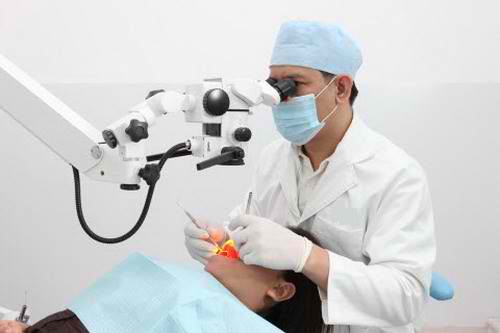If you’ve watched any television lately, you probably noticed how modern technology has enhanced your viewing pleasure. High definition television has given us a better picture and viewing quality — just for our entertainment. Imagine how much easier it would be for your dentist to perform more complicated dental procedures with a better view. Like HD technology, dental microsurgery allows your dentist to see every detail of your mouth — and improves dental treatment for you as well!
Dental microsurgery is basically dental surgery that utilizes a dental microscope and fiber optic lighting system. Dentists use a Dental Operating Microscope (DOM) to magnify the area, giving them a more precise view of the procedure. Because magnification spreads light out, making the area appear darker, many dental microscopes also include a fiber optic light to illuminate the area more thoroughly than traditional overhead light sources.Let’s Scope Things Out
Dental Operating Microscopes are starting to replace the need for dental loupes, which work like a magnifying glass. There are significant differences between dental loupes and dental microsurgery — for instance, dental microscopes offer better magnification. Dental loupes magnify the surgical area 3 to 6 times its original size, while dental microscopes provide far greater detail, enlarging the field of vision up to 20 times. Dentists can also adjust the level of magnification during dental microsurgery, while dental loupes are designed to fit a set distance between the dentist and patient, limiting mobility.
Like dental loupes, Dental Operating Microscopes are worn like glasses, but they can also be mounted on a wall or table. Some dental microsurgery systems include a tiny camera that displays the procedure on a video monitor for all in the dental operatory to see — these can also be recorded for educational purposes. Although dental loupes may include a light source, they are often separately attached to the glasses, resulting in a heavier appliance. Some dentists prefer the less cumbersome dental microscopes, many of which have the light source integrated into the lens.The Dental Angle
Dental Microsurgery can be used to enhance any dental procedure but is most often reserved for more complex oral surgery cases. Dentists often take advantage of dental microsurgery in the following cases:
- The placement of dental implants
- Locating the tooth’s roots and infection during root canal procedures
- An apicoectomy, where the root’s tip is surgically removed to treat a root canal
- Periodontal surgery or gum disease treatment
- Locating small cracks or defects in the tooth
- The removal of dental restorations and instruments, including files, posts and fillings that need to be dislodged during endodontic retreatment
From Your Viewpoint
You’ve learned how dental microsurgery benefits your dentist, but what do you get out of it? Because the dental microscope magnifies the area, dental microsurgery usually means less cutting and fewer stitches. Dental microscopes may also reduce the need to pull back the gums, which could result in less bleeding. The precision of dental microscopic procedures often make for faster treatment and less healing time.
The utilization of dental microsurgery could also lower the occurrence of failed dental treatments, which means less need for retreatment. For these reasons, the dental community is starting to embrace the use of dental microsurgery.

